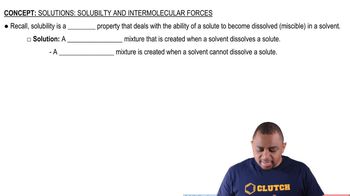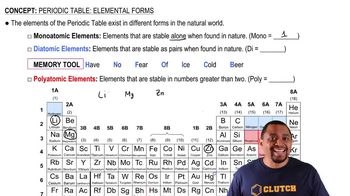Classify each statement as an observation, a law, or a theory. a. Chlorine is a highly reactive gas. b. If elements are listed in order of increasing mass of their atoms, their chemical reactivities follow a repeating pattern. c. Neon is an inert (or nonreactive) gas. d. The reactivity of elements depends on the arrangement of their electrons.
Ch.1 - Matter, Measurement & Problem Solving
Chapter 1, Problem 37
Classify each substance as a pure substance or a mixture. If it is a pure substance, classify it as an element or a compound. If it is a mixture, classify it as homogeneous or heterogeneous. a. sweat b. carbon dioxide c. aluminum d. vegetable soup
 Verified step by step guidance
Verified step by step guidance1
Identify the characteristics of a pure substance and a mixture. A pure substance has a uniform and definite composition, while a mixture contains two or more substances physically combined.
For each substance, determine if it is a pure substance or a mixture. Consider the uniformity and composition of each.
Classify pure substances further into elements or compounds. Elements consist of only one type of atom, while compounds consist of two or more types of atoms chemically bonded.
Classify mixtures as homogeneous or heterogeneous. Homogeneous mixtures have a uniform composition throughout, while heterogeneous mixtures have a non-uniform composition.
Apply these classifications to each substance: a. Sweat is a mixture, b. Carbon dioxide is a pure substance (compound), c. Aluminum is a pure substance (element), d. Vegetable soup is a mixture.

Verified video answer for a similar problem:
This video solution was recommended by our tutors as helpful for the problem above.
Video duration:
2mWas this helpful?
Key Concepts
Here are the essential concepts you must grasp in order to answer the question correctly.
Pure Substances vs. Mixtures
A pure substance consists of a single type of particle and has a uniform composition throughout, which can be classified as either an element or a compound. In contrast, a mixture contains two or more different substances that retain their individual properties and can be separated by physical means. Understanding this distinction is crucial for classifying substances correctly.
Recommended video:
Guided course

Solubility and Mixtures
Elements and Compounds
Elements are pure substances that cannot be broken down into simpler substances by chemical means and consist of only one type of atom. Compounds, on the other hand, are substances formed when two or more elements chemically bond together in fixed proportions. Recognizing whether a substance is an element or a compound is essential for proper classification.
Recommended video:
Guided course

Elemental Forms of Elements
Homogeneous vs. Heterogeneous Mixtures
Homogeneous mixtures have a uniform composition throughout, meaning that the different components are evenly distributed and not easily distinguishable, such as saltwater. Heterogeneous mixtures contain visibly different substances or phases, like vegetable soup, where the individual components can be seen and separated. This classification helps in understanding the nature of mixtures.
Recommended video:
Guided course

Solubility and Mixtures
Related Practice
Textbook Question
32
views
1
rank
Textbook Question
Classify each substance as a pure substance or a mixture. If it is a pure substance, classify it as an element or a compound. If it is a mixture, classify it as homogeneous or heterogeneous. a. wine b. beef stew c. iron d. carbon monoxide
36
views
Textbook Question
Determine whether each molecular diagram represents a pure substance or a mixture. If it represents a pure substance, classify the substance as an element or a compound. If it represents a mixture, classify the mixture as homogeneous or heterogeneous.
31
views
